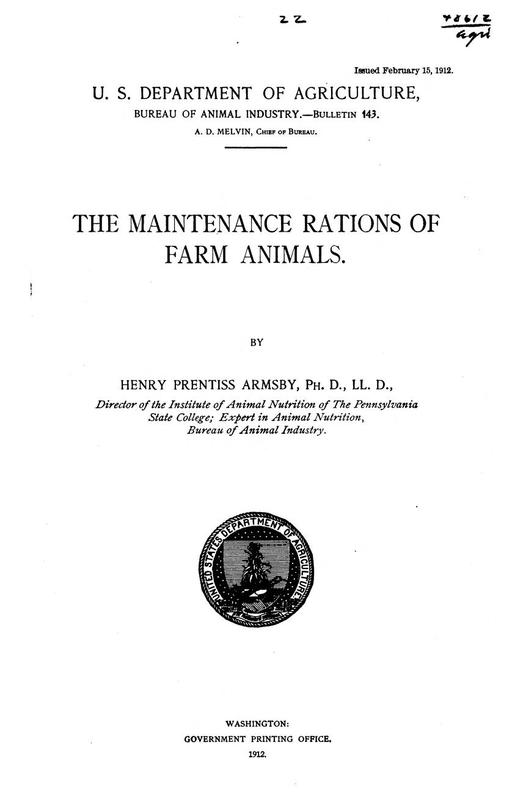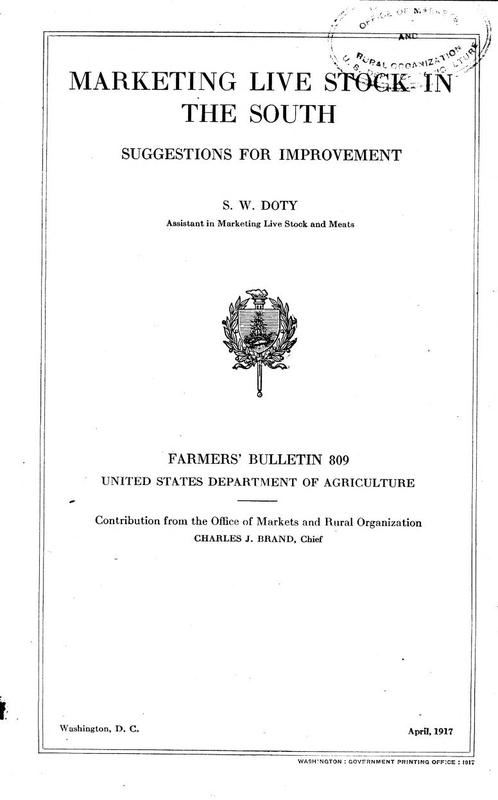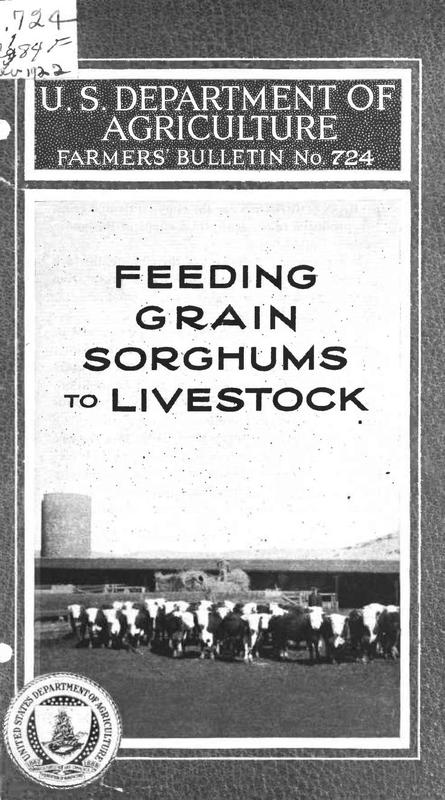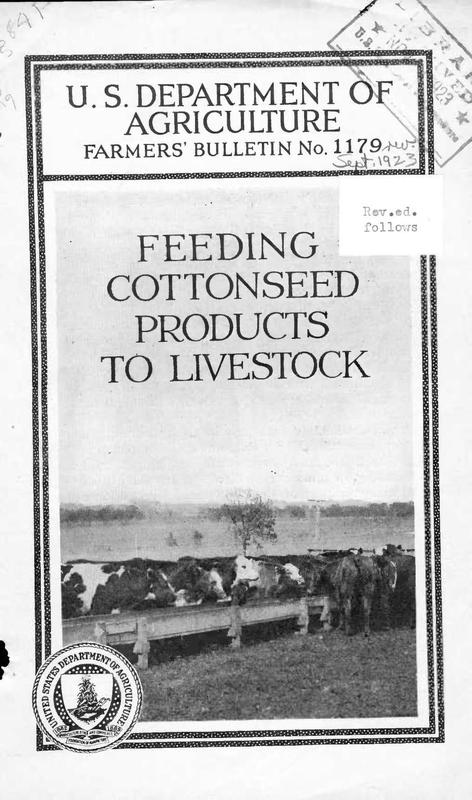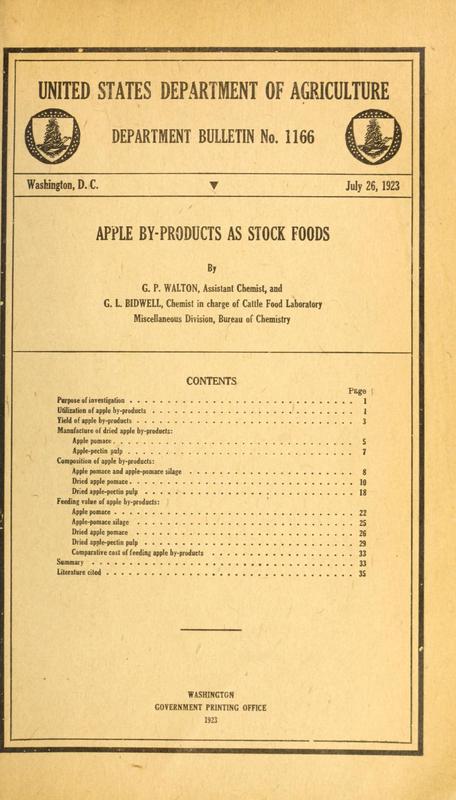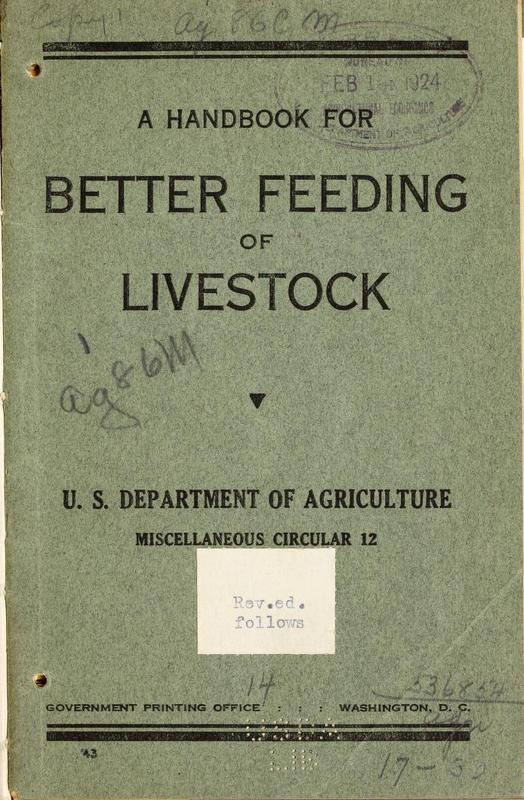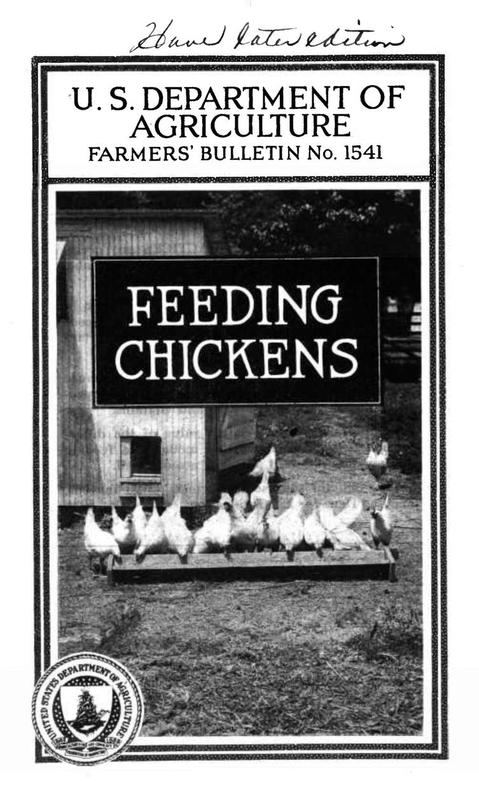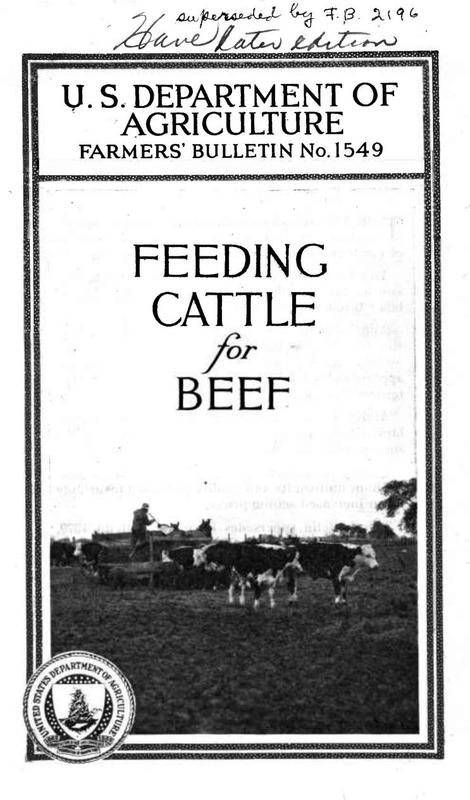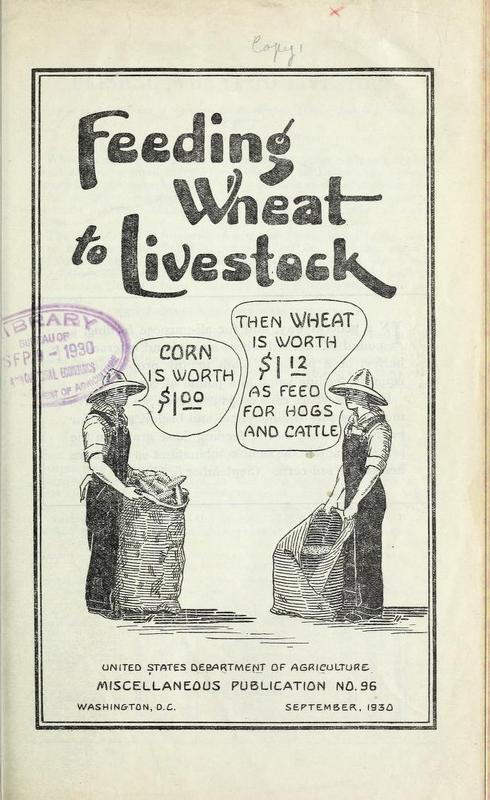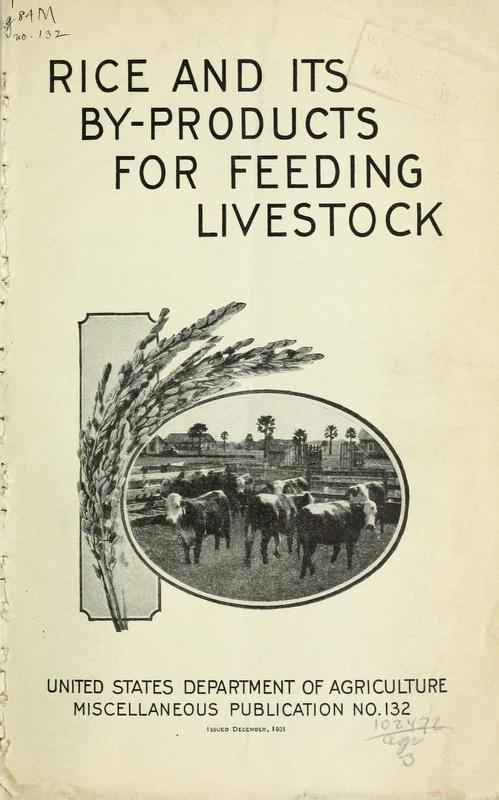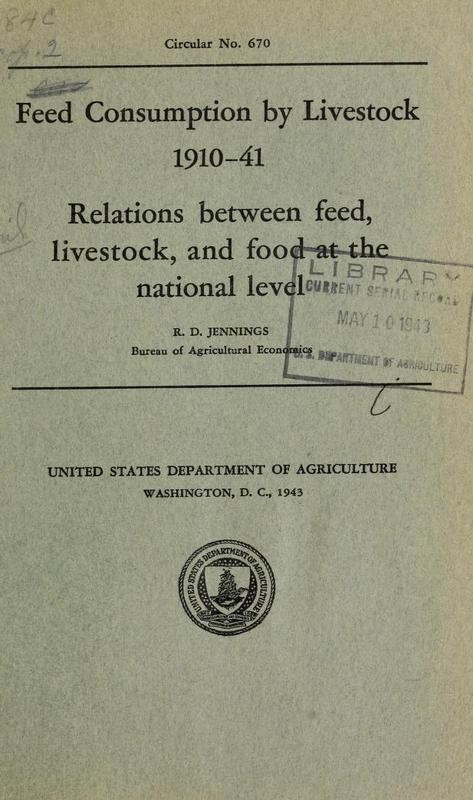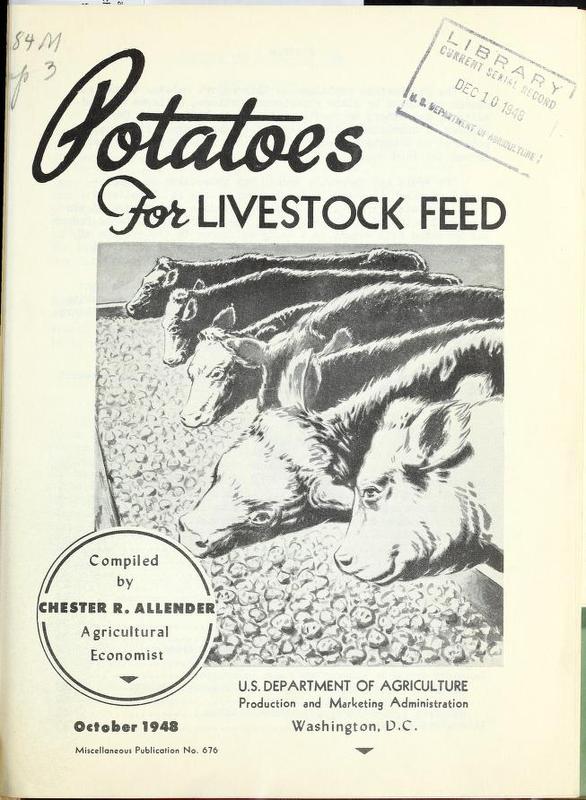USDA Historical Publications on Animal Nutrition
The U.S. Department of Agriculture created many publications that described the knowledge of the time about best methods for feeding farm animals such as cattle, chickens, and pigs.
Here is a small sample of historical USDA documents that addressed livestock nutrition for the small farmer, created around the time of Carver's bulletins.
(Click any image in this exhibit to get more information, including access to full text)
"Feed is supplied to farm animals in order that they may either yield products useful to man as materials for human food and clothing or serve him by the performance of mechanical work. But as a factory must first be supplied with enough power to keep in motion the shafting, belting, and other machinery before any product can be turned out, so the animal mechanism must be provided with sufficient feed to maintain the processes essential to life before any continued production is possible. The amount of feed required for this purpose is called the maintenance ration of the particular animal.
It is the quantity of feed necessary simply to support the animal when doing no work and yielding no material product. If an animal receiving exactly a maintenance ration were subjected to a so-called balance experiment, there would be found an exact equality between income and outgo of ash, nitrogen, carbon, hydrogen, and energy, showing that the body was neither gaining nor losing protein, fat, carbohydrates, or ash.
The word 'maintenance' is sometimes used popularly in another sense to signify the total amount of feed required, for example, by a horse in order to perform his daily work or by a calf in order to make a normal growth. It is important to grasp the idea that, in its technical sense, the maintenance requirement means the minimum required simply to sustain life. The feed of the horse or calf would, from this point of view, be regarded as consisting of two portions; one of these is the maintenance ration, which if fed by itself would just support the horse at rest or the calf without growth, and the other the productive portion of the ration by means of which work is done or growth made. To recur to the illustration of the factory, the maintenance ration keeps the empty machinery running, while the additional feed furnishes the power necessary to turn out the product."
"The outlet for southern farmers' live stock lies chiefly with local butchers and shippers, and therefore is limited and often unsatisfactory. Not un- commonly farmers slaughter their animals without previously arranging for the sale of the dressed carcasses and, because of the perishable nature of their product, are forced to sacrifice it on an over-supplied market.
Local packing houses have benefited farmers accessible to them by providing a year-round market. Co-operative shipping and marketing clubs, local live stock buying companies, and the establishment of specified market points, with sales on advertised dates, also have improved marketing conditions greatly.
Many farmers market their hogs as cured meats, which are sold to dealers or to consumers. In preparing farm-cured meats in the South, artificial refrigeration is desirable. This may be provided by individual or community meat-curing houses. Some local ice and cold-storage plants cure meats for farmers; others purchase the dressed hogs and cure on their own account. Ice plants might extend this business.
These local marketing plans have proved successful in various communities and have increased the number of live stock produced. They are therefore offered in this bulletin as suggested remedies to communities with inadequate markets."
"Grain sorghums are the chief cultivated crops produced in the semiarid sections of the southwestern United States.
On account of the dryness of the climate, the lack of transportation facilities, and the distance from markets most of this region can be used only as range for cattle and sheep.
Most of the cattle and sheep in this area must be given some feed to carry them through the winter satisfactorily. Therefore, the importance of grain sorghums for this purpose is evident. In addition, there are times of drought when the range fails during the summer months.
As grain sorghums make good silage, they may be ensiled and held in reserve without appreciable deterioration for several years. Stockmen can thereby insure themselves against heavy losses such as frequently occur in times of protracted drought."
"The following points have been determined from experiments and practical feeding operations. They should be kept in mind and carefully followed in feeding cottonseed products to live stock:
(1) Do not feed cottonseed meal to young calves.
(2) Horses and pigs should be fed cottonseed products only in small quantities and then with great precaution.
(3) Procure prices on high-grade and low-grade cottonseed meal and choose the feed which supplies protein at the least cost.
(4) For feeding cattle:
(a) One pound of cottonseed meal is usually considered worth as much as 2 pounds of corn or its equivalent.
(b) Heavy rations of cottonseed meal should be discontinued after 100 to 120 days when dry roughage is fed, and after 150 days when succulent feeds are used.
(c) Cottonseed cake may be used profitably as a supplemental feed for fattening cattle on pasture.
(5) In sections where much corn, stover, fodder, timothy, or other carbohydrate feed is used it is extremely important that some feed like cottonseed meal be used.
(6) Cottonseed meal stimulates the appetites of fattening animals and causes them to consume more feed and likewise to make greater gains.
(7) Cottonseed meal is a very valuable protein feed for dairy cows. One pound of good-quality cottonseed meal is usually considered equal to 2 pounds of wheat bran for milk production."
"Shortly after the close of the World War American manufacturers became greatly interested in the possibilities of utilizing dried apple pomace and similar dried residues as stock foods. Information, founded on scientific research, concerning the feeding value of dried apple by-products and their effect on the production of milk when fed to cows was limited. Accordingly, the Bureau of Chemistry of the United States Department of Agriculture undertook an investigation of the utilization as stock food of dried apple pomace and dried apple-pectin pulp. Special attention was given to the value of the dried pomace and pectin pulp as sources of succulence for cows during the winter.
The first industrial problem in connection with the by-products of the apple probably arose with the first crude attempts to prepare a drink from its juice. Evidently the early cider makers were not greatly impressed with the value of cider press cake, or apple pomace, as food for stock, in spite of the fact that Cato and Varro and other Roman writers on agricultural subjects had advocated the feeding of grape marc, the refuse from wine making. The use of apple pomace as a food for stock may have been ignored for the reason that, according to Evelyn and Mortimer the fruit employed for making cider at that time was so harsh that swine refused to eat it even before the juice had been extracted."
"Great numbers of farmers have expressed to the United States Department of Agriculture their interest in problems of better feeding, growth, and development of livestock.
This handbook has been prepared by department feeding specialists for distribution to farmers who desire a handy-sized set of simple rules and reference tables to be followed in feeding the different classes of farm animals. It aims to aid farmers in under- standing the principles of better feeding and in using the best practices which are adaptable to conditions on their farms.
No set of specific feeding rules can be wisely applied throughout the country. Local conditions, seasonal changes, and many other factors combine to make the best feeding practices change from place to place and from time to time. This handbook discusses the main points most commonly encountered in feeding, but which should always be adapted to local conditions. More general discussions of feeding practices will be found in Farmers' Bulletins and other publications of the department, also in publications of the State agricultural colleges and experiment stations."
"Efficient feeding practices are necessary to make poultry raising most profitable and to produce the best quality of products.
The feed is the most important cost factor in raising poultry. Therefore the selection of feeds and the method of feeding are very important matters.
In feeding all classes of poultry a proper balance of the various nutrients is necessary, especially proteins, carbohydrates, minerals, and vitamins.
In this bulletin the relative value of the different nutrients is discussed and methods of feeding chickens for different purposes are outlined."
"The feeding of cattle for beef production affords one of the most practical ways of disposing of grain and roughages produced on the farm.
This industry favors diversification in agriculture and makes possible a well-balanced distribution of labor throughout the year.
Approximately 75 per cent of the fertilizing constituents of feeds fed to livestock is returned in the manure; consequently when the manure is saved and applied to the land, feeding operations largely maintain soil fertility.
Ability in buying and selling cattle and in combining feeds properly has a direct bearing on the success of beef-cattle feeding.
Quality in feeder cattle favors economical production; uniformity and quality combined invariably mean increased selling prices."
"In a general way, and for all-purpose feeding, a pound of cracked wheat or a pound of cracked barley, or a pound of both in any proportion, is equal in feeding value to a pound of corn.
Farmers whose corn crops are short can now save money by substituting wheat and barley, pound for pound, for corn, and in feeding those grains in the same way and in the same combinations as they have heretofore fed corn. (September 5, 1930.)
Wheat is not usually regarded as a substitute for corn as a feed for livestock, but a small carry-over of old corn and a new crop greatly reduced by the drought leaves many farmers short of corn for feed. With the other feed grain supplies only about equal to the amounts normally fed, the main source for making up the shortage of corn is wheat.
The August (1930) forecasts of the wheat crop added to the carry-over indicate a supply of about 1,096,000,000 bushels, which is 131,000,000 above the 5-year average, 1924-1928, and about 440,000,000 above the average amount used annually for human food and seed in the United States. Already some of this surplus has been exported."
"The annual production of rice in the United States has increased in the last 30 years from about 100,000 tons of milled rice to more than 500,000 tons. Approximately 40,000 tons of rice bran, 15,000 tons of rice polish, and at least 10,000 tons of brewers' rice are available annually for livestock feeding.
In parts of the coastal plain of the Gulf States, where about three-fifths of the rice crop of the United States is produced, it is the most important grain crop. In southwestern Louisiana and southeastern Texas it is the principal source of cash income. In some parishes and counties in this area more than 75 per cent of the cultivated land is used in a rotation which includes the growing of rice. Other rice-producing areas of nearly equal importance are the grand prairie of Arkansas and the Sacramento Valley of California."
"Feed for livestock suddenly becomes of crucial importance in meeting the crucial needs of the United Nations for food. For 10 years the emphasis of agricultural leaders has been on holding down the over- abundant supplies of feed and keeping the fertility in the soil against a time of need. That time is here and now. Milk, meat, eggs, must be produced in quantities never before attempted. Production of feed is the principal occupation of many farmers and is of at least secondary importance on most other farms. How this feed is produced and utilized is now of prime concern.
In answering the question as to how much more feed is needed to produce a given quantity of milk or hogs or eggs, it is necessary to know how much feed of the different kinds it takes to produce 100 pounds of milk, hogs, or a dozen eggs under average conditions. When the total quantity of feed needed is known, it is then possible to ascertain whether the goals of livestock production are realizable, and to determine changes in the production of feed and in feeding practices that will facilitate the attainment of the desired goals.
The principal contribution of this circular to this problem is found in the data on feed consumption per unit of livestock which is given in several tables. The data on livestock numbers and livestock production and feed production used in arriving at the rates of feed consumption in these tables are the official estimates of the Department of Agriculture insofar as they are available. The data used herein are averages for the United States and are thus made up of information that is representative of a variety of conditions which may differ widely from the average in feed requirements for a particular product. Beef cattle in the Southwest, for instance, get almost all their feed from grass; in the East much hay and corn fodder are fed, and some grain; in Corn Belt feed lots, cattle get a heavy feed of corn. Dairy cows in the East get a heavy grain ration; in the West less grain and more hay are fed. These data therefore are not applicable as they stand in any one region, State, or smaller territory, and this is especially true of the data for cattle and sheep. Utilization of the feed resources of the country at the national level is considered here."
"Since enactment of the Steagall Amendment of July 1, 1941 into law, the price-support program for potatoes has brought to public attention problems that have confronted potato growers for many years. During large crop years before the inauguration of the price- support program, growers either failed to harvest a part of their crops or they dumped a quantity of potatoes at the end of the marketing and storage season. Some of the remaining potatoes were fed to livestock. The development of economic outlets for low-grade and surplus potatoes is of vital importance to the industry; and the recent focusing of public attention on the need for governmental removal of surplus potatoes is giving new life to the search for such outlets.
This report outlines the value of potatoes for livestock feed. It is designed to serve also as a handy guide for live-stock feeders and potato growers by summarizing the major research work that has been completed or has progressed sufficiently to permit a useful report.
Every year a substantial quantity of the potato crop is found to be unsuitable for human food or for seed. The quantity varies greatly from place to place and from year to year, according to changes in weather, growing conditions, and production and handling practices. It is estimated from various trade reports and data available in the United States Department of Agriculture that 10 to 20 percent of the national production each year, or, on an average, about 50 million bushels should be classed as culls and unsuitable for human consumption. From the estimated utilization of the crop, it appears that approximately half of this quantity is moved into commercial channels. The remainder includes shrinkage, waste, and the quantity fed to livestock or otherwise used on the farm where grown."
 An official website of the United States government.
An official website of the United States government.


